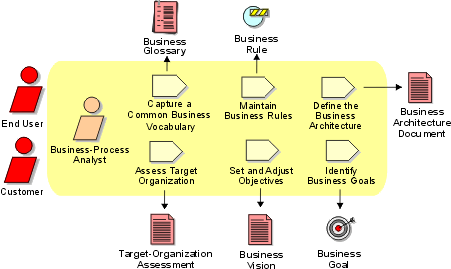Workflow Detail: Assess
Business Status
|
The purpose of this workflow detail is to assess the status of the organization, and set business modeling objectives. |
|
|
|
Description

The purpose of this workflow detail is to:
- Assess the status of the organization (called the target organization), identify improvement areas, and document these in the Target-Organization Assessment and the Business Architecture Document.
- Understand how to categorize the project and identify what business-modeling scenario is the best fit (see Concepts: Scope of Business Modeling).
- Make decisions about how to continue working in the current iteration and outline how to work in subsequent iterations with the business-modeling artifacts.
- Develop a preliminary understanding of the objectives (a Business Vision) of the target organization that can be agreed upon by the stakeholders and the business-modeling team.
This workflow detail commences with an assessment of the organization. The goal is to delimit the business-modeling effort. The assessment might be performed at varying levels of effort and detail. The amount of effort you invest depends upon the reason for change. The results of the assessment, including the current status of the organization, reasons for change, problems, and improvement areas are documented in the Target-Organization Assessment.
While performing the assessment, it might be necessary to maintain a list of commonly used terms and definitions, which are captured in the Business Glossary. It might also be necessary to consider the business architecture and document it in the Business Architecture Document. Any business rules uncovered during this process must be captured in the Business Rules.
Once the current situation has been described, the desired situation is captured in the Business Vision. The problem to be solved or opportunity to be exploited must be well defined. It is essential to set clear, realistic business-modeling objectives in order to determine the right scope and depth of the business-modeling activities to perform. A large part of this workflow detail involves gaining consensus and managing expectations. The Business Vision must be supported by all stakeholders in order for the business-modeling effort to have any chance of success.
While defining objectives and setting expectations for the business-modeling effort, Business Goals may be uncovered. These must be documented because, they will later be used to validate the Business Use Cases.
Related Information 
This section provides links to additional information related to this workflow detail.
Timing 
Early Inception phase.
Optionality 
Recommended, as a means of delimiting the business modeling effort.
How to Staff

Your business-modeling team, all of whom act as Business-Process Analysts, invites the stakeholders' representatives to understand the problem to be solved and the character of the business domain of the target organization. This extended business-modeling team needs good business-domain knowledge as well as an understanding of how software systems are currently used to automate the business. The core team needs to have strong facilitation and business-modeling skills.
If business modeling is done with the intention of re-engineering an existing organization, it is very important to involve those people who will work at this task in the new organization. First, these people know how things work; they are the best sources of ideas for improvement. Second, they must feel that they are part of the work because they are going to "own" the new organization.
There are at least three ways to involve those people who are going to work in the new organization in the envisioning work:
- Make them members of the business-modeling team.
- Interview them for their ideas and opinions based on their experience.
- Ask them to review the results.
Work Guidelines

Developing the Business Vision is the task of a business-modeling team It can be done through a series of workshops, with the follow-up work done by individuals. Facilitate a workshop in which the goal is to determine the scope of the business-modeling effort. The following sample techniques can be applied to help you collect correct and relevant information:
The decisions you make about how to use the business-modeling discipline's workflow and the vision of the future target organization are closely related. Depending on what you want to achieve, the approach you take to business modeling may be more or less comprehensive. Typically, the first iteration of a project-in the Inception phase-focuses on producing the Target-Organization Assessment and only briefly outlines the Business Vision and Business Architecture Document. During the Elaboration phase, you will revisit the Business Vision and the Business Architecture Document to make them more complete.
This content developed or partially developed by  Empulsys BV. Empulsys BV.
|

